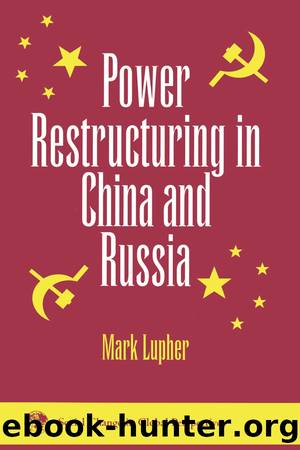Power Restructuring in China and Russia by Mark Lupher

Author:Mark Lupher [Lupher, Mark]
Language: eng
Format: epub
Tags: Social Science, Political Science, World, Asian, Regional Studies
ISBN: 9780429966644
Google: p__EDwAAQBAJ
Goodreads: 38634035
Publisher: Routledge
Published: 2018-02-12T00:00:00+00:00
6
Chinese Communism, Maoism, and the Origins of the Cultural Revolution
Power restructuring in Communist China is comparable in sociopolitical scale and world-historical significance to power restructuring in the Soviet Union. In this chapter, I chart power-restructuring dynamics during the first two decades of Chinese Communist rule, 1949 to 1966. My discussion encompasses the nationwide consolidation of CCP power in the early 1950s, the momentous campaigns and sociopolitical collisions of the late 1950s, power relations and political process in the early 1960s, and the eruption of the Cultural Revolution in summer and fall 1966. I demonstrate that power dynamics during the first two decades of Chinese Communist rule often paralleled those of the Soviet 1920s and 1930s and of the Soviet 1950s and early 1960s as well. While exploring these similarities, I also identify the crucial differences that distinguish Chinese Communist power restructuring from the Soviet experience. In this chapter, I focus special attention on processes of concentration and control, contending developmental strategies, the deconcentration and decentralization of power, political conflict at the top and at the societal level, and top and bottom versus the middle power-restructuring processes.
In the early 1950s, CCP power was successfully established at all levels of Chinese society, and a national program of social, economic, and technological transformation was set in motion. In contrast to the limited reach of the Soviet state in the 1920s, the mobilizational and coercive capacities of Chinas new rulers in the 1950s were formidably well developed and far-reaching. Even as they presided over massive structural transformations, however, Chinaâs leaders faced developmental dilemmas and became divided by policy disputes that closely paralleled those of the Soviet 1920s. In the late 1950s, these dilemmas and disputes were manifested in two pivotal sociopolitical upheavalsâthe Hundred Flowers Movement and the Great Leap Forward. While delineating these cataclysmic events and their aftermath, I consider the origins of the most fateful power-restructuring episode in the history of Chinese communismâthe Cultural Revolution. My discussion in this chapter concludes with an analysis of the preliminary stages and opening salvoes of this watershed event. In Chapter 7, I undertake a more extended analysis of the Cultural Revolution, delineate its unintended consequences, and assess its historical significance.
Power restructuring in the first two decades of Chinese Communist rule should be viewed from three complementary perspectives: the historical experience of Chinese communism; the dilemmas of building a new political, economic, and social order; and the challenge of reforming a communist system. As a revolutionary movement based in the countryside, drawing on peasant support, and built up over more than two decades, Chinese communism differed in its experience and worldview from those of the Bolsheviks. During the CCPâs protracted sojourn in the Chinese countryside, the party developed power-restructuring methods that would be deployed with potent effect on the partyâs ascent to national power. Yet as Marxist-Leninists, the Chinese Communists looked to the Soviet Union for support and inspiration and sought to emulate Soviet economic and institutional achievements. In the course of building up a communist system,
Download
This site does not store any files on its server. We only index and link to content provided by other sites. Please contact the content providers to delete copyright contents if any and email us, we'll remove relevant links or contents immediately.
Spell It Out by David Crystal(35861)
Life for Me Ain't Been No Crystal Stair by Susan Sheehan(35550)
Cecilia; Or, Memoirs of an Heiress — Volume 1 by Fanny Burney(32093)
Cecilia; Or, Memoirs of an Heiress — Volume 3 by Fanny Burney(31481)
Cecilia; Or, Memoirs of an Heiress — Volume 2 by Fanny Burney(31435)
The Great Music City by Andrea Baker(30931)
Professional Troublemaker by Luvvie Ajayi Jones(29445)
We're Going to Need More Wine by Gabrielle Union(18664)
Twilight of the Idols With the Antichrist and Ecce Homo by Friedrich Nietzsche(18324)
The Secret History by Donna Tartt(18267)
All the Missing Girls by Megan Miranda(14857)
Cat's cradle by Kurt Vonnegut(14804)
Pimp by Iceberg Slim(13828)
Bombshells: Glamour Girls of a Lifetime by Sullivan Steve(13718)
Fifty Shades Freed by E L James(12936)
Talking to Strangers by Malcolm Gladwell(12916)
Norse Mythology by Gaiman Neil(12879)
The Social Justice Warrior Handbook by Lisa De Pasquale(11969)
Underground: A Human History of the Worlds Beneath Our Feet by Will Hunt(11857)
